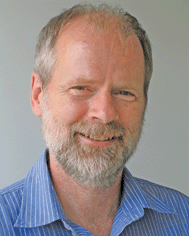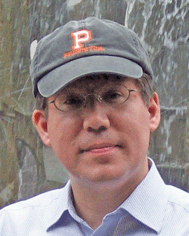Rapid complexity generation in natural product total synthesis†
Huw M. L. Daviesa and Erik J. Sorensenb
aDepartment of Chemistry, Emory University, 1515 Dickey Drive, Atlanta, Georgia 30322, USA. E-mail: hmdavie@emory.edu
b67 Frick Laboratory, Princeton University, Princeton, NJ, USA. E-mail: ejs@princeton.edu
 Huw M. L. Davies | Huw M. L. Davies was born in Aberystwyth, Wales, UK. He began his independent academic career at Wake Forest University. In 1995, he moved to the University at Buffalo, the State University of New York, where he held the positions of UB Distinguished Professor and Larkin Professor of Organic Chemistry. In 2008, he joined the faculty at Emory University as the Asa Griggs Candler Professor of Chemistry. His research program covers design of chiral catalysts, development of new synthetic methodology, total synthesis of biologically active natural products, and development of chiral therapeutic agents. A major current research theme in his group is catalytic asymmetric C–H functionalization. |
 Erik J. Sorensen | Erik Sorensen received his Bachelor of Arts degree in Chemistry from Syracuse University and began his graduate studies in chemical synthesis at The University of California, San Diego in 1989. Under the direction of Professor K. C. Nicolaou, he contributed to a laboratory synthesis of the cancer drug Taxol®, co-authored Classics in Total Synthesis, and obtained his PhD in 1995. After completing an NSF postdoctoral fellowship with Professor Samuel Danishefsky, he started his independent career at The Scripps Research Institute in 1997. In 2003, he moved his research group to Princeton University where he is the Arthur Allan Patchett Professor in Organic Chemistry. |
As the field of organic synthesis becomes more sophisticated, the focus of natural product total synthesis has moved away from simply achieving the synthesis of a particular target to ensuring that the synthetic approach is elegant and streamlined (and offers ideas and methods to the broader field of synthesis). This themed issue has contributions from many of the leaders in the fields of natural product total synthesis and new synthetic methodology development. The issue illustrates the current state of the art of natural product total synthesis and points out exciting new directions for further development.
Some of the tutorial reviews give an overview of the most spectacular achievements in streamlining natural product total synthesis. Newhouse, Baran and Hoffmann (DOI: 10.1039/b821200g) illustrate the guiding principles of how to achieve economies in total synthesis. Kim and Movassaghi (DOI: 10.1039/b819925f) give an overview on how biogenetically inspired syntheses can greatly simplify the synthesis of alkaloid natural products. The review by Miller and Williams (DOI: 10.1039/b816705m) focuses on the various approaches that have been designed for the synthesis of the bicyclo[2.2.2]diazaoctane ring system, common to a number of important natural products.
The development of cascade, domino or tandem reactions, in which several individual steps are combined in a synthetic sequence, can be highly effective for streamlining total synthesis. Nicolaou and Chen (DOI: 10.1039/b903290h) illustrate through many classic examples how cascade reactions can be broadly applied to the synthesis of a diverse range of natural products. Poulin, Grisé-Bard and Barriault (DOI: 10.1039/b819798a) give an overview of how domino reactions that include at least one pericyclic reaction can be effectively used for the construction of natural carbocyclic frameworks. Jamison and co-workers (DOI: 10.1039/b816697h) illustrate how epoxide-opening cascade reactions in water can be applied for the rapid construction of the complex ladder polyether family of natural products.
Concerted reactions are extremely useful for the rapid construction of natural products because they can result in exquisite stereocontrol at multiple stereocenters. The Diels–Alder reaction has a venerable history as a strategic reaction in natural product synthesis, and Juhl and Tanner (DOI: 10.1039/b816703f) describe its recent applications. Perreault and Rovis (DOI: 10.1039/b816702h) discuss the use of multi-component cycloaddition strategies for the catalytic asymmetric synthesis of alkaloid targets, while Zakarian and co-workers (DOI: 10.1039/b901177n) give an overview of recent applications of [3,3]-sigmatropic rearrangements for the total synthesis of natural products.
Certain types of building blocks have broad application for the synthesis of natural products. Schindler and Carreira (DOI: 10.1039/b915448p) showcase how oxabicyclo[2.2.1]heptene building blocks can be used for the rapid formation of structural complexity. Carson and Kerr (DOI: 10.1039/b901245c) illustrate the scope of cyclopropane ring-opening reactions for the synthesis of heterocyclic natural products. Hilt and Weske (DOI: 10.1039/b902344p) describe the application of aromatic compounds as synthons for 1,3-dicarbonyl compounds. Sorensen and co-workers (DOI: 10.1039/b912599j) describe the rich chemistry of acylketenes and their application in natural product synthesis, while Cowen and Miller (DOI: 10.1039/b816700c) cover complexity generation from the use of catalytic enantioselective reactions of allenoates.
Transition metal catalysis has had a great impact on modern organic synthesis and many processes can be widely used for the rapid construction of natural products. Padwa (DOI: 10.1039/b816701j) describes the scope of rhodium carbenoid-induced domino reactions for the synthesis of alkaloids, while Davies and Denton (DOI: 10.1039/b901170f) give an overview of the application of donor/acceptor carbenoids to the synthesis of natural products. The gold- and platinum-catalyzed reactions of alkynes have enjoyed explosive growth in recent years and Fürstner (DOI: 10.1039/b816696j) covers recent examples of this methodology as a convenient tool for generating molecular complexity. Kozlowski and co-workers (DOI: 10.1039/b821092f) describe the application of transition metal-catalyzed oxidative coupling reactions for the enantioselective synthesis of biaryl natural products. Stereoselective transition metal-catalyzed C–H activation reactions have considerable promise for natural product synthesis and Yu and co-workers (DOI: 10.1039/b816707a) describe the current status of this field. Finally, biotransformations and biocatalysis have been extensively applied to complexity generation in organic synthesis, and Hudlicky and Reed (DOI: 10.1039/b901172m) give an overview of this topic.
The themed issue highlights the excitement and challenges associated with modern natural product total synthesis. The field continues to advance at a rapid pace and the emphasis on streamlining total synthesis offers great opportunities for creative strategies and solutions.
Footnote |
| † Part of the rapid formation of molecular complexity in organic synthesis themed issue. |
| This journal is © The Royal Society of Chemistry 2009 |
